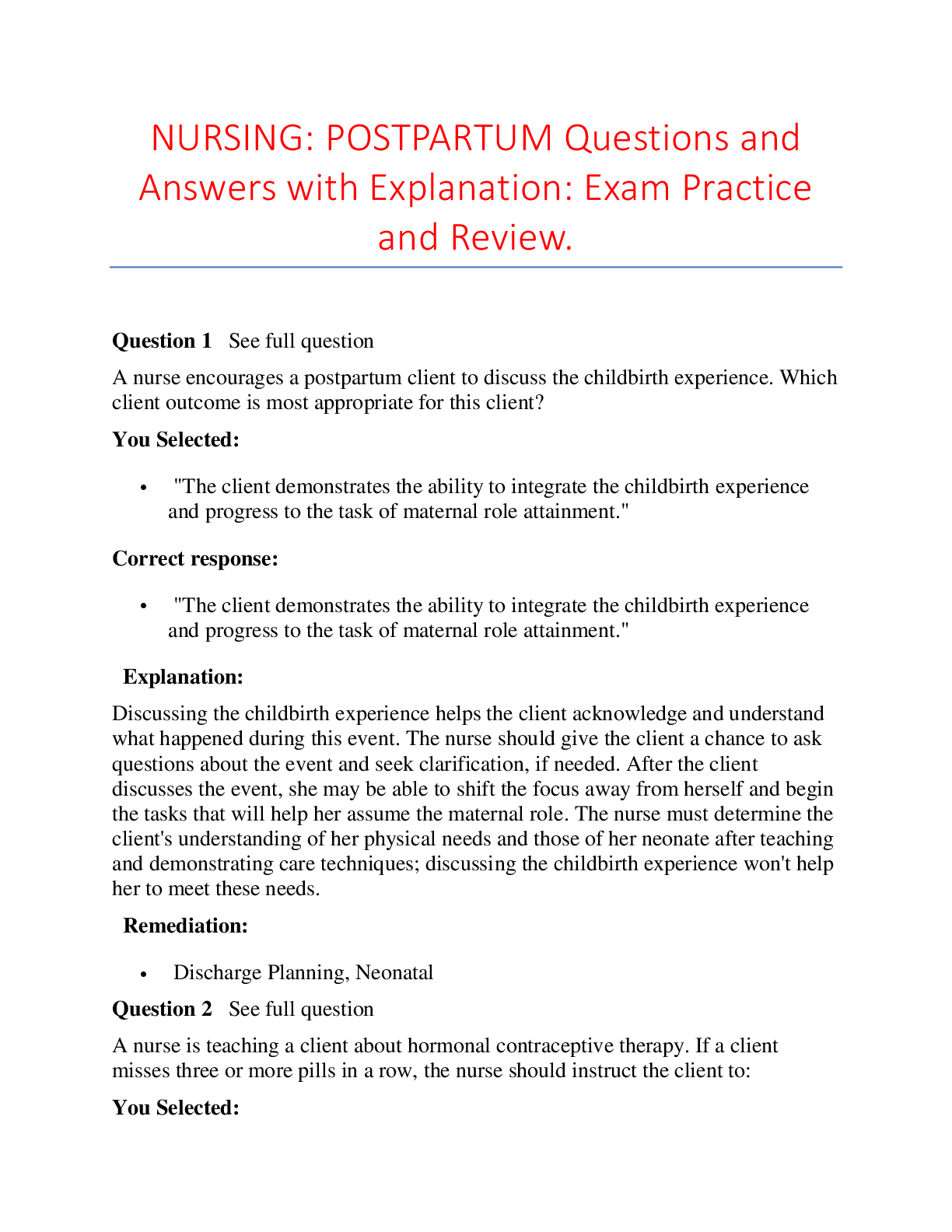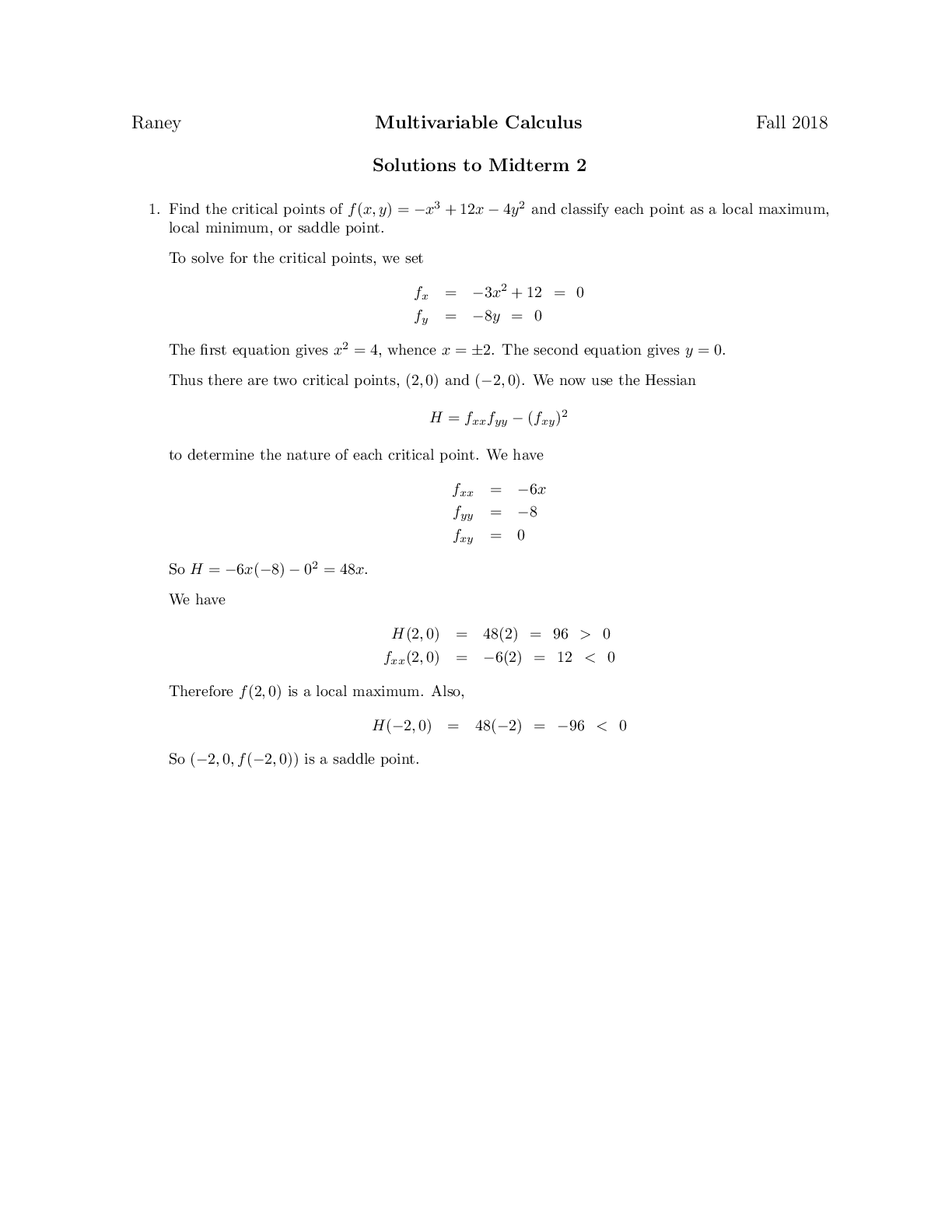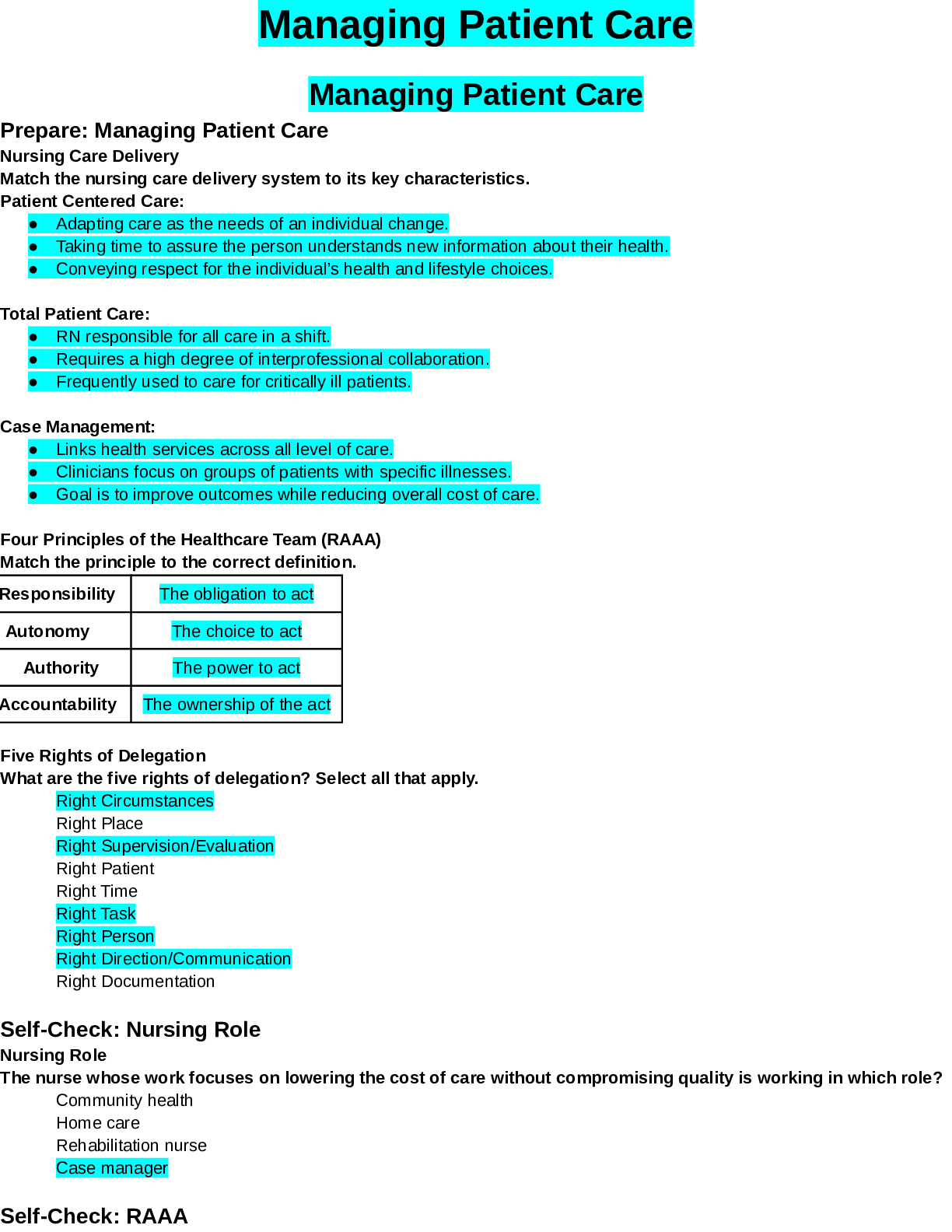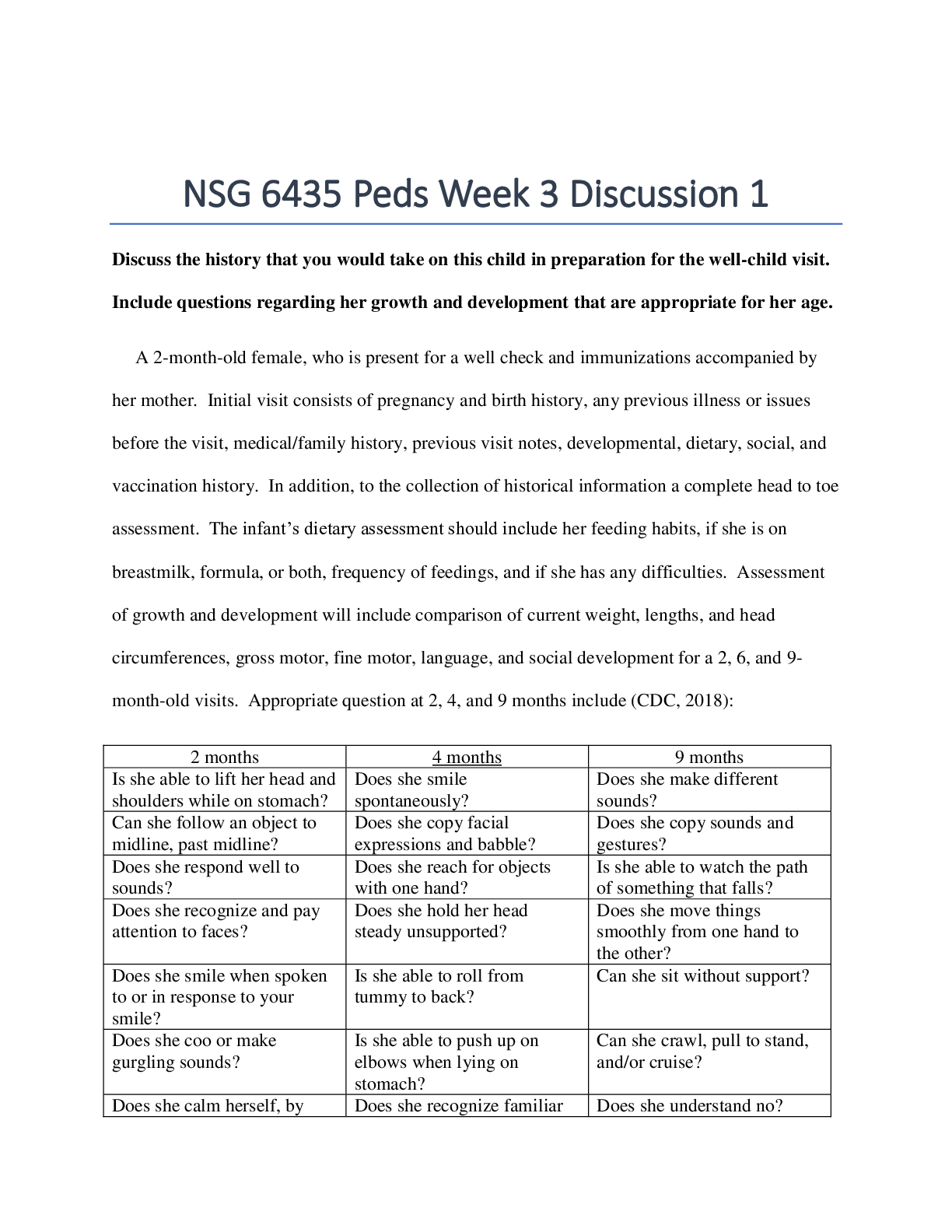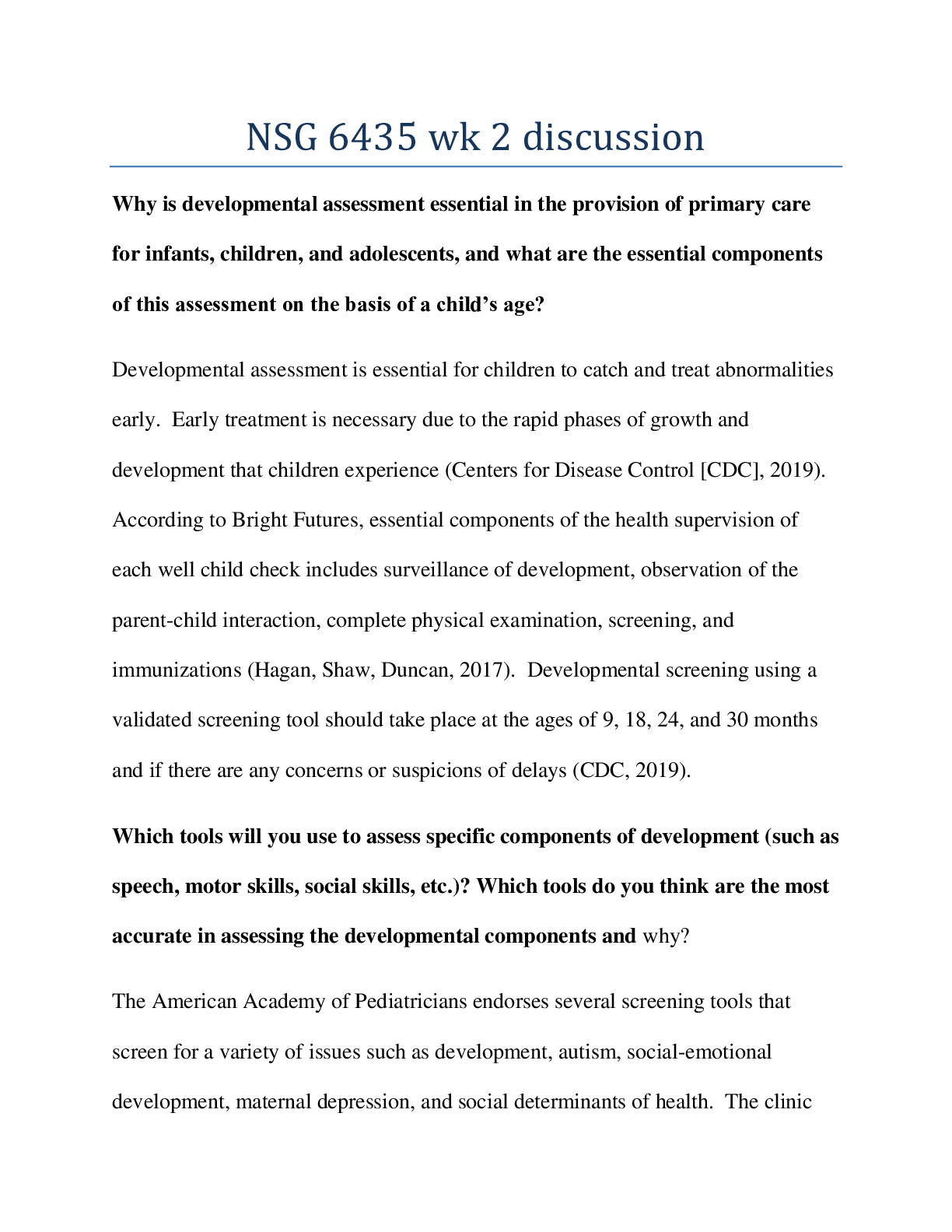*NURSING > QUESTIONS & ANSWERS > ADVANCED PATHOPHYSIOLOGY NSG5003 Week 9 Quiz. Queations and Answers. 100%. (All)
ADVANCED PATHOPHYSIOLOGY NSG5003 Week 9 Quiz. Queations and Answers. 100%.
Document Content and Description Below
Question 1. Question : A criterion for a diagnosis of generalized anxiety disorder (GAD) is a period of excessive worrying that lasts for at least how many months? Student Answer: 3 ... 6 9 12 Question 2. Question : The existence of regular, deep, and rapid respirations after a severe closed-head injury is indicative of neurologic injury to the: Student Answer: Lower midbrain Pontine area Supratentorial tissues Cerebral area Question 3. Question : Which term is used to describe a hernial protrusion of a saclike cyst that contains meninges, spinal fluid, and a portion of the spinal cord through a defect in the posterior arch of a vertebra? Student Answer: Encephalocele Meningocele Spina bifida occulta Myelomeningocele Question 4. Question : Which term is used to describe a complication that can result from a spinal cord injury above T6 that is producing paroxysmal hypertension, as well as piloerection and sweating above the spinal cord lesion? Student Answer: Craniosacral dysreflexia Parasympathetic dysreflexia Autonomic hyperreflexia Retrograde hyperreflexia Question 5. Question : With receptive dysphasia (fluent), the individual is able to: Student Answer: Respond in writing but not in speech. Produce verbal speech but not comprehend language. Comprehend speech but not verbally respond. Neither respond verbally nor comprehend speech. Question 6. Question : Dilation of the ipsilateral pupil, following uncal herniation, is the result of pressure on which cranial nerve (CN)? Student Answer: Optic (CN I) Abducens (CN VI) Oculomotor (CN III) Trochlear (CN IV) Question 7. Question : The neural groove closes dorsally during which week of gestational life? Student Answer: Second Fourth Eighth Twelfth Question 8. Question : Which type of seizure starts in the fingers and progressively spreads up the arm and extends to the leg? Student Answer: Complex psychomotor seizure Focal (partial) Jacksonian seizure Generalized seizure Atonic/drop seizure Question 9. Question : A right hemisphere embolic cerebrovascular accident (CVA) has resulted in left-sided paralysis and reduced sensation of the left foot and leg. Which cerebral artery is most likely affected by the emboli? Student Answer: Middle cerebral Vertebral Posterior cerebral Anterior cerebral Question 10. Question : The link between major depression and cortisol secretion is that individuals with depression: Student Answer: Show suppression of plasma cortisol when given dexamethasone. Have a decreased plasma cortisol level, despite the administration of exogenous corticosteroids. Show that persistently elevated plasma cortisol levels can result in inflammation that is believed to trigger depression. Have normal plasma cortisol levels throughout the day when they take antidepressant medication, as prescribed. Question 11. Question : The most likely rationale for body temperature fluctuations after cervical spinal cord injury is that the person has: Student Answer: Developed bilateral pneumonia or a urinary tract infection (UTI) Sustained sympathetic nervous system damage resulting in disturbed thermal control Sustained a head injury that damaged the hypothalamus’s ability to regulate temperature Developed septicemia from posttrauma infection Question 12. Question : Stage 1 intracranial hypertension is caused by the: Student Answer: Loss of autoregulation that normally maintains constant blood flow during changes in cerebral perfusion pressure Displacement of cerebrospinal fluid (CSF), followed by compression of the cerebral venous system Vasoconstriction of the cerebral arterial system with a reciprocal increase in systemic blood pressure Compression of the medulla oblongata in the brainstem by herniation of the cerebral cortex Question 13. Question : The most common primary CNS tumor is the: Student Answer: Microglioma Neuroblastoma Astrocytoma Neuroma Question 14. Question : The most critical aspect in correctly diagnosing a seizure disorder and establishing its cause is: Student Answer: Computed tomography (CT) scan Cerebrospinal fluid (CSF) analysis Skull X-ray studies Health history Question 15. Question : The weakness resulting from the segmental paresis and paralysis characteristic of anterior horn cell injury is difficult to recognize because: Student Answer: Upper motor neurons are involved. The injury is microscopic. Two or more nerve roots supply each muscle. The person is unable to feel the involved muscles. Question 16. Question : It is true that Guillain–Barré syndrome (GBS): Student Answer: Is preceded by a viral illness Involves a deficit in acetylcholine Results in asymmetric paralysis Is an outcome of human immunodeficiency virus (HIV) Question 17. Question : Which group is most at risk of spinal cord injury from minor trauma? Student Answer: Children Adolescents Adults Older adults Question 18. Question : Which characteristic is a medical criterion of brain death? Student Answer: Akinetic mutism Coma Apnea Locked-in syndrome Question 19. Question : Characteristics of primary motor neuron atrophy include: Student Answer: Loss of sensation in distal, proximal, or midline muscles Fasciculations and muscle cramps Flaccid paralysis with paresthesia Spastic paralysis with increased deep tendon reflexes Question 20. Question : Which midbrain dysfunction causes pupils to be pinpoint size and fixed in position? Student Answer: Diencephalon dysfunction Oculomotor cranial nerve (CN) dysfunction Dysfunction of the tectum Pontine dysfunction [Show More]
Last updated: 2 years ago
Preview 1 out of 9 pages

Buy this document to get the full access instantly
Instant Download Access after purchase
Buy NowInstant download
We Accept:

Reviews( 0 )
$9.00
Can't find what you want? Try our AI powered Search
Document information
Connected school, study & course
About the document
Uploaded On
Jul 14, 2020
Number of pages
9
Written in
Additional information
This document has been written for:
Uploaded
Jul 14, 2020
Downloads
0
Views
109

